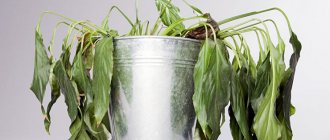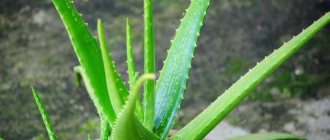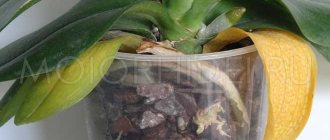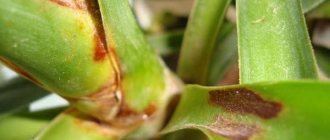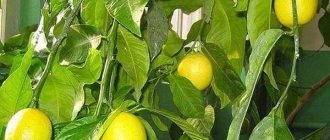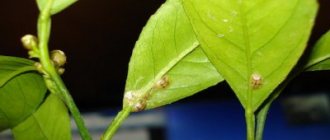Frequent problems that arise when growing lemons
The natural habitat of citrus fruits is the tropics; achieving such a climate in an ordinary city apartment is quite difficult. Therefore, many flower lovers consider growing them somewhat troublesome. At the same time, several of the most common problems are noted. In particular, the tree may shed its leaves and stop growing.
The causes of such phenomena can be a variety of factors: from insufficient volume of soil to the container to excessive dryness of the same soil or even the air in the room. In addition, plants are sensitive to mineral and nutrient deficiencies, as well as to the quality of light.
But even more often you can find complaints from amateur flower growers on forums that yellowing of the leaves is observed on the lemon. We will try to sort this issue out.
Signs of missing elements
Lemon is picky about the composition of the soil. He should regularly receive nitrogen, phosphorus, potassium and iron. In smaller doses it needs manganese, calcium, boron, magnesium, etc.
By the type of yellowing of the crown, you can understand what elements the lemon lacks. Here are some examples:
- Lack of nitrogen. Many light yellow small dots appear on the leaf blades.
- Phosphorus. A deficiency of this component is indicated by yellowing of the leaf blade at the edges.
- Iron. With iron deficiency, the leaves turn light yellow. Only the veins remain bright green. This disease is called chlorosis.
For such symptoms, only the missing component is added. The rest of the time, complex fertilizers are used.
Causes of yellowing lemon leaves
Often the cause of yellowing leaves is improper care of the plant. If your lemon leaves are turning yellow, it may be reacting to one of the following factors.
Incorrect lighting
Both excess and lack of light can cause yellowing of leaves. When exposed to direct sunlight, yellow burns appear on the leaves. If a lemon has light leaves with yellow spots, it is too dark.
Uncomfortable temperature
Lemon is a heat-loving plant. It reacts negatively to drafts and temperature changes. If a citrus fruit freezes, its leaves begin to turn yellow and curl at the edges. As a result, the indoor lemon sheds its leaves.
Excessive watering
He loves moist soil, but everything needs moderation. Due to excess moisture, the roots begin to rot. The leaves evenly turn yellow and fall off.
Depleted soil
If yellow dots appear between the veins, it means there is not enough nutrition.
Dry air
Citrus fruits are native to the tropics, so they prefer air with high humidity. If the tips of the leaves of a lemon dry out, the leaves gradually turn yellow and fall off, this indicates that the air is too dry for the citrus fruit.
Diseases
Lemons are very susceptible to various diseases. At home, it is difficult for them to become infected, but there is a high risk of acquiring a diseased sprout. If the care is correct, but the tree still turns yellow and dies, a disease is most likely to blame.
Natural causes
If 1-2 leaves have turned yellow and the rest of the plant looks healthy, this is most likely a sign of natural foliage renewal.
Diseases
The cause of yellowing of the crown and tips of the shoots is often various diseases. Many of them cause similar symptoms. To solve the problem, it is enough to prescribe the correct treatment.
Gommoz
Gommosis is a fungal disease in which cracks form on the trunk and branches . Gum begins to ooze out of holes in the bark. This leads to disruption of sap flow. The crown does not receive enough nutrition, which is why the leaf blades turn yellow and begin to shed their leaves.
To save the plant, the infected shoots are removed and the affected areas on the trunk are cut out. The cut areas are covered with garden pitch, and the indentations on the trunk are washed with copper sulfate and covered with garden pitch. The tree is sprayed with fungicide.
Note! In advanced cases, gommosis cannot be treated.
Root rot
Root rot is one of the most insidious diseases. Its danger lies in the fact that it becomes noticeable only at a late stage of plant damage.
The main visible symptom of root rot is the wilting of the crown - it looks as if it has been scorched.
To save the lemon, it is removed from the pot. The roots are cleared of soil and washed in water at room temperature. All affected areas are cut off. The remaining part of the root system is washed in copper sulfate.
The tree is transplanted into a new pot filled with drainage and soil. All materials must be disinfected. The soil around the trunk is compacted and watered with warm water.
RESCUE OF CITRUS. Lemon sheds its leaves. What to do with citrus leaf fall?
Sooty fungus
Sooty mildew is another fungal disease. A black coating forms on lemon leaves. It can be easily washed with a cloth or damp hand. Without timely treatment, the crown turns yellow and crumbles. The ends of young branches also begin to hurt.
Getting rid of sooty fungus is not difficult. To do this, wipe off the black coating with a damp cloth. Do not put too much pressure on the sheet plate so as not to damage it.
After erasing the sooty fungus, the tree is sprayed with a solution prepared from 1 teaspoon of copper sulfate and 5 liters of water. Another option is to treat the plant with a fungicide.
Note! Sooty fungus only affects citrus fruits with weakened immune systems. In most cases, this disease is a consequence of plant damage by pests.
Scab and warts
Scab and warts are diseases caused by fungi and bacteria. Affected leaves and shoots become deformed. Dark spots and raised formations form on them. The disease affects not only the crown of the tree, but also its fruits.
Without timely treatment, the plant begins to turn yellow and dry out. Eventually the leaves fall off and the lemon dies.
To treat the disease, fungicides are used, for example, Aktara or copper sulfate solution. The product is sprayed on a citrus plant.
Before you start processing the lemon, tear off all affected areas. It is recommended to water the soil in the pot.
Pests and their control
A houseplant can be attacked by a wide variety of pests.
Most often it is affected by:
- aphids
- whitefly
- thrips
- spider mites
- false scale insect
- mealybugs
- nematodes
Each of the pests weakens the tree, feeds on its juices and may well cause wilting or yellowing of the leaves; young shoots and leaves of plants are especially often affected by sucking insects.
You can fight pests using appropriate chemicals, fortunately, the choice of them is now simply huge. The limitation should be the fact that the processing will be carried out indoors.
If desired, you can use homemade, plant-based products that are less toxic to humans and pets.
Experts say that this kind of problem can be completely avoided if you follow simple preventive measures:
- The soil should be disinfected before planting
- It is recommended to keep new purchased flowers in quarantine for about a month; placing them next to disease-free flowers that have been living in the house for a long time can only be done after making sure that they are healthy
- It is advisable to place bouquets of flowers brought into the house away from pots with other green pets
- Systematic washing of the leaves with running water will also protect citrus trees; this can be done once a month.
Why do branches dry out and leaves fall?
Problems with drying leaves and twigs of citrus appear if the plant is located in too dark a place, as a result it suffers from stagnation of water in the soil and lacks moisture in the air. After normalization of conditions, the appearance of the lemon should be restored.
In addition to excess or lack of moisture, drying out of branches can be caused by spider mites. Insufficient potassium, phosphorus or nitrogen in the soil can also cause this problem. Feeding with all the microelements necessary for citrus will help it recover.
Principles of proper care
In order for lemon to feel good at home and its leaves not to turn yellow, you need to follow the rules for caring for this whimsical plant:
- The lighting should be bright but comfortable. It is best to place the lemon pot on the south or east side. If there is insufficient light, artificial lighting should be added.
- Drafts and temperature changes must be avoided. Do not place a lemon near a radiator or next to an open window.
- Do not overwater the plant. If this happens, the lemon needs to be replanted. If the roots rot, they need to be trimmed and dried.
- To ensure that the plant has enough nutrition, fertilizing should be used. It is best to choose special fertilizers for lemon.
- To maintain optimal humidity, the leaves need to be regularly sprayed with water. A humidifier will not be amiss.
- If pests are detected, it is necessary to thoroughly wash the inside of the leaf with a soapy solution or treat the tree with insecticides.
With proper care, lemon looks great. If you neglect to care for the citrus tree, it may die. When yellow leaves appear, it is necessary to immediately identify the cause and eliminate it.
Let's watch an interesting video with care recommendations:
Air humidity
It would seem that you have taken into account all the points for caring for lemon, but the lemon leaves still turned yellow. What to do? Pay attention to the humidity level in the room. Excessive dry air is another cause of discomfort for the plant. It is optimal to maintain the humidity level within 60–70%. After all, high humidity can lead to fungal diseases of the tree.
What measures should be taken? During the summer or heating season, you can place a lemon near the humidifier. If you don't have a humidifier, regularly spray the leaves with soft water at room temperature. You can also place various containers of water near the lemon. Experienced gardeners make a small greenhouse for the plant without a top: such a shelter will protect the plant not only from dry air, but also from drafts.
Watering with bad water
Why do the tips of the leaves of indoor lemons dry out is a question that worries many. It would seem that you have read all the basic recommendations from experts, you know what and how to do so that your home shrub quickly takes root in its new environment and at one point begins to form fruits. But something went wrong, and now the lemon tree faces a sad fate, as it is actively shedding its dried leaves.
Finding out the cause of the problem is not difficult, since there are only a few of them. The first thing you should pay attention to is the peculiarities of watering an indoor lemon tree.
It’s one thing to know that the root system of a lemon can dry out or rot if you do not approach the regularity and intensity of watering correctly, and quite another to understand that the quality of water is of great importance for your indoor plant. In the process of growing lemon at home, this is a basic requirement.
In greenhouses and botanical gardens, professional flower growers use special, pre-settled water. Of course, spending money on purified water for irrigation is an unaffordable expense for many. However, there are some things you can do at home.
The main thing is to understand what exactly is different about the liquid for irrigating the substrate, which is purchased by experienced gardeners, and what nuances are typical for ordinary tap water. Interestingly, the second option is not recommended for moistening the soil in which indoor lemon grows.
The thing is that such water contains chlorine and fluorine. These mineral elements can cause a lot of damage to a dried out indoor lemon tree. If you constantly saturate the plant with such components, your indoor flower will suffer significantly as a result: the tips of the leaves may turn yellow and dry out.
Why homemade lemons don't bloom?
Sometimes it happens that citrus does not bloom for a very long time. In this case, the tree can be encouraged to flower by grafting with a cultivated cutting. After this, flowers will appear in 2-3 years. The reason why homemade lemons do not bloom may be the lack of a cool winter (at a temperature of 12-15°C), when the plant begins to develop flower buds. In a warm room, without a dormant period, citrus may not bloom. In addition, the tree may lack trace elements.
Lemons grown from seeds very rarely bloom and bear fruit. To achieve flowering, it is necessary to graft a branch of a fruiting plant. Flowering will occur in 3-4 years.
When planting lemons, you should know that some varieties bloom annually, while others bloom once every 4-5 years.
Temperature
One of the main reasons why lemon leaves may turn yellow is a violation of the temperature regime. Sudden changes in temperature or drafts negatively affect their crown. Dry and yellowing leaves often indicate stress.
Most varieties can easily tolerate a decrease in temperature from 25 to 10 °C, but in this case it is important that these indicators change gradually, without sudden changes. The optimal temperature for keeping citrus fruits is about 20 °C.
If the leaves of a lemon begin to turn yellow and fall off, then pay attention to the place where it stands. If batteries or other heating devices are placed near it, then the movement of hot air and cold from the window negatively affects its crown. It is better to move the plant away from heating devices and eliminate drafts during its restoration.
Lemon should be kept away from the heating radiator
